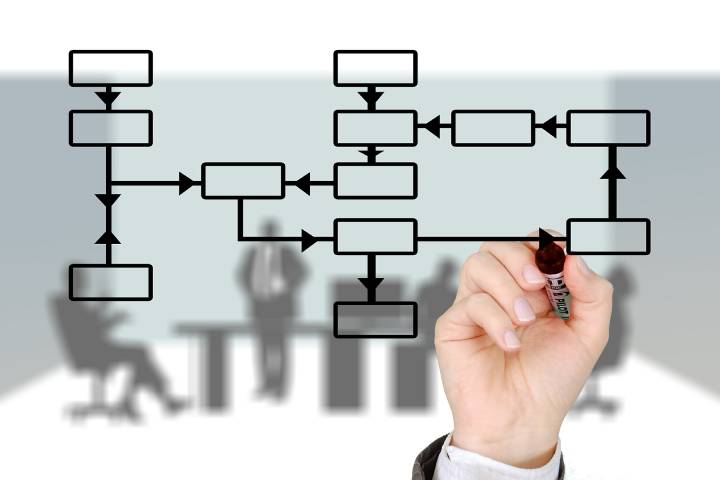The terms Industry 4.0 and digitization in the context of business processes are often the focus of debates in politics as well as in the economic and educational sectors. Discussions often focus on topics such as the optimization and automation of business processes and the competitiveness of small and medium-sized companies. Current studies still show the need for action for digitization measures in Germany. The potential for business process optimization and digitization is particularly evident in small and medium-sized companies. Nevertheless, questions arise that deal with the way in which such a project can be implemented. Because some entrepreneurs either do not have sufficient knowledge or a corresponding amount of information that they cannot cope with without IT experts. The question of the recognizable benefit is also still often asked. Therefore, we would like to show small and medium-sized companies a guide for this topic, classify the terms and describe process models. We would like to make the following contribution:
- Reduce the barriers to process optimization and automation
- Creating transparency by classifying terms
- Increase the self-confidence of small and medium-sized companies with regard to innovation and digitization
Basics For The Optimization And Automation Of Business Processes
The development of the business process towards its automation consists of different phases that should be run through. Starting with the process definition up to optimization, followed by digitization and its subsequent automation. These phases are systematically presented and explained in this article. First of all, the essential terms should be defined.
Definition of the term business process
A business process is a chain of content-related activities that must be carried out for the creation and utilization of services and lead to a completed result that makes a significant contribution to the company’s success.
Definition of the term process management
Process management includes all planning, organizational, and control measures for the targeted control of the value chain of a company with regard to the setting of objectives (costs, time, quality, innovative ability, customer satisfaction).
Definition of the term process model
New information technologies make processes possible that can contribute to an increase in effectiveness and efficiency in many ways. With the help of modeling tools, the creation of process models can be simplified. These form the template for the design of information systems. Process models help to design and optimize processes. Process engines execute processes directly on the basis of process models. In order to be able to design process models that are as high-quality and proper as possible, these are usually designed on the basis of principles. These are:
- Principle of correctness
- Principle of relevance
- Principle of clarity
- Principle of comparability
- Systematic structure principle
- Principle of economy
Business Process Optimization
When optimizing business processes, the aim is to improve existing processes by analyzing, evaluating, and adapting or even redesigning them if there is a recognizable improvement potential. Measurable variables are, for example, the time or cost savings or the efficiency and throughput time of a process.
Approaches to the optimization of business processes: Various approaches can be pursued to optimize processes. We show two known approaches.
Business Process Reengineering: The approach here is to achieve sustainable increases in productivity by making substantial adjustments to the processes. For this purpose, the basic organizational assumptions are checked and examined in order to reduce avoidable organizational and cultural restrictions during the redesign.
Determination of the maturity level: A maturity level model comprises a sequence of so-called maturity levels and thus describes an anticipated, desired, or typical development path. Maturity levels are defined by specified characteristics and characteristics. Maturity models pursue the goals of measuring progress, uncovering deficits, and recognizing optimization potential. The measures for optimization are defined with the help of priorities. In addition, the requirements of the stakeholders can be taken into account, which is incorporated in the adaptation of the process.
Digitization As Part Of The Optimization And Automation Of Business Processes
After the business processes have been assessed, they can be optimized. Measures for digitization can be included in the definition of the target. This can be done, for example, by defining appropriate interfaces and integrating systems in the course of designing improved processes. These are usually simple processes. Such a process can be the sending of a form between two departments via internal mail. As part of the optimization and digitization of business processes, existing systems that are used by both departments can be used to send the files instead of in-house mail.
Business Process Automation
In the course of automating business processes, the most effective and most important step is to identify suitable processes with a correspondingly high potential for optimization. Not all processes are suitable for automation. In particular, complex and constantly changing processes are considered unsuitable because their dynamic properties make long-term automation very difficult to achieve. You should therefore orientate yourself on the selection criteria for automatable processes when choosing the processes.
Conclusion
As part of this article, the phases from optimization to automation of business processes were shown. The criteria and phases mentioned make it clear how important a suitable partner with appropriate expertise is for the implementation of such a project. We are happy to answer any questions you may have on the subject!
